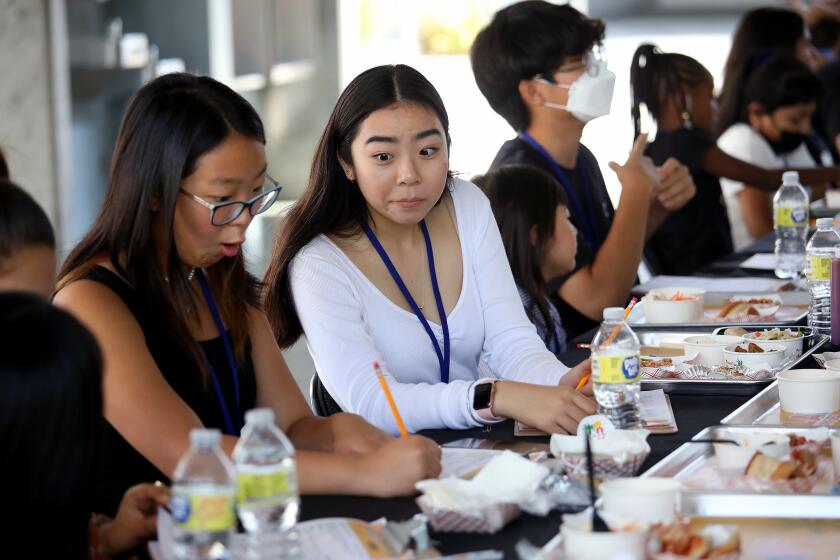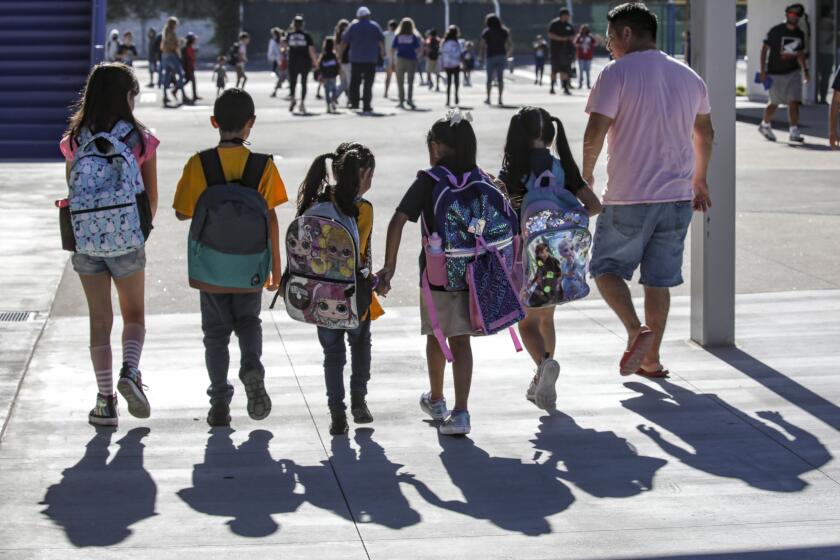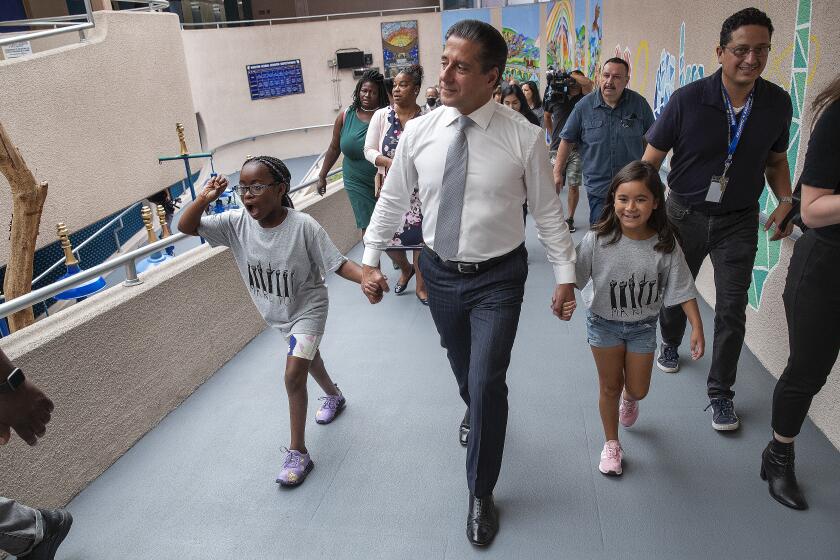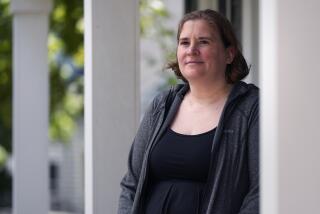
An inside look at how LAUSD develops and prepares new menu items — and what the kids really think about them.
- Share via
At precisely 11:35 a.m. on a recent Friday, hundreds of kids with backpacks slung over their shoulders file through the blue and red doors of the Garfield High School lunchroom in East Los Angeles. Many carry books, folders and brightly colored notebooks. Some chat enthusiastically as they dig their hands into foil bags of crunchy snacks. A line quickly forms through the dining area and into the cafeteria, where the day’s offerings are on display under bright warming lights.
The students make their way down the line and fill their trays with wrapped cheeseburgers and spicy breaded chicken sandwiches, floppy wedges of cheese and pepperoni pizza, bowls of penne pasta with turkey meatballs under red sauce, plastic containers of chicken Caesar salad, vegan Chik’n nuggets, roasted potato wedges, bagged sliced apples and cartons of milk. Mostly, it looks like the quality of food you might find at a sports stadium concession stand.
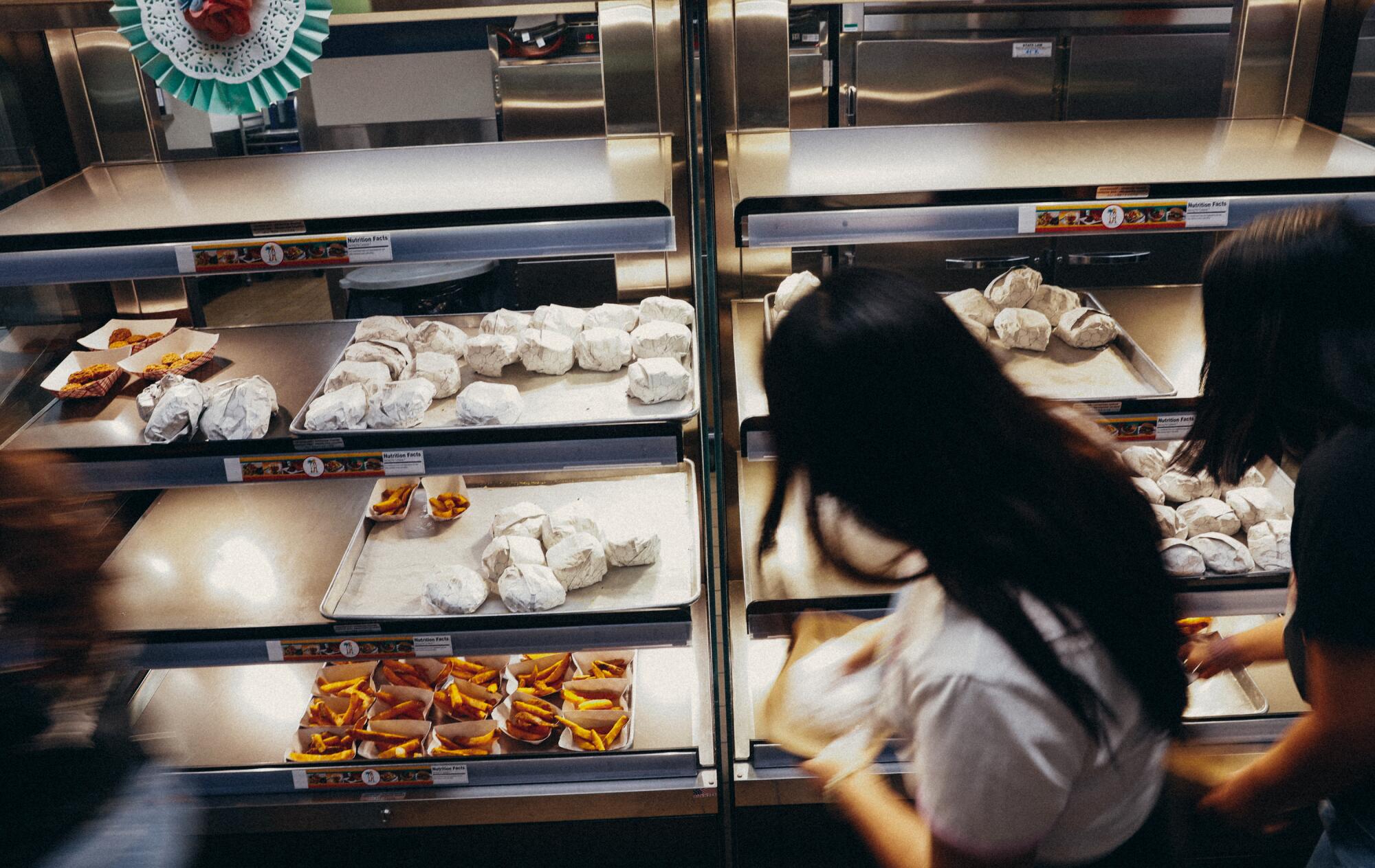
“It’s constant, but we’re a well-oiled machine,” says the high school’s cafe manager, Mario Fiore. Every day that school is in session, Fiore arrives at the East Los Angeles school between 5:30 and 6 a.m. to open the kitchen, take care of the morning’s deliveries and input yesterday’s supper participation numbers into a computer. The culinary school graduate has worked at a country club, the Circus Circus hotel in Las Vegas and the Ritz Carlton, but for the past 16 years, he’s been with the L.A. school district, the second largest in the country.
“We usually feed around 1,500 kids a day,” he says.
Fiore estimates that he goes through around 600 to 800 pounds of fruit, 2,000 slices of bread, several hundred gallons of milk and 100 gallons of fruit juice a week. He’s used to feeding large groups, but what happens during that 30-minute lunchtime service at Garfield High School, and at dozens of other schools across the city, is nothing short of a small miracle.
Café L.A., the food services division of the Los Angeles Unified School District, serves more than 107 million meals a year. It’s a feat that requires an army of cooks, kitchen managers and nutritionists coordinating across more than 1,000 schools. They must adhere to strict sets of nutrition guidelines for each meal and, most important, appeal to the picky palates of kids.
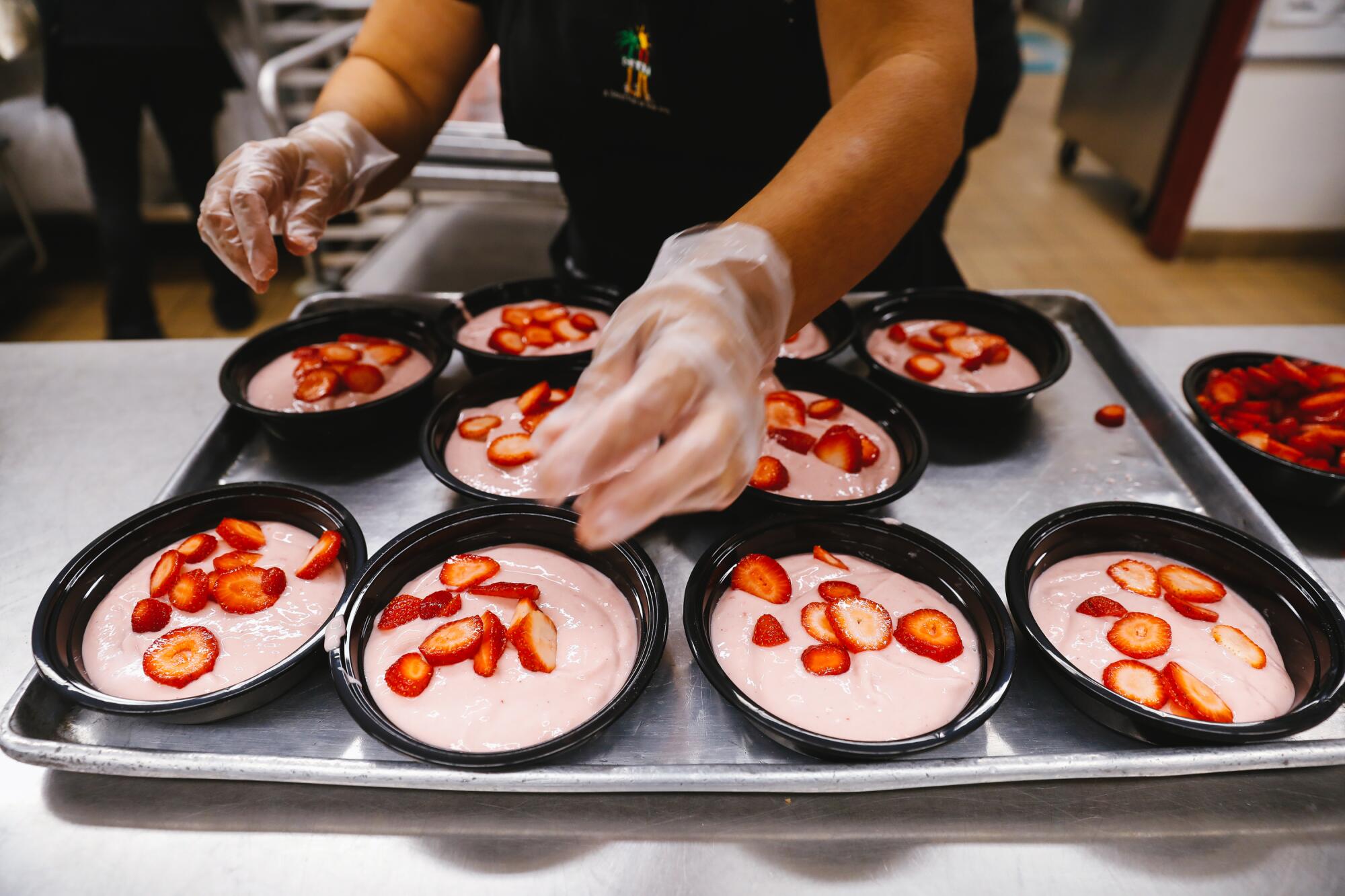
During that Friday lunch rush, Garfield High School senior Leah Richardson, 17, squeezes in a quick lunch with three friends before a pep rally.
“Not all of us can bring lunch from home and oftentimes it’s nice to have warm food during lunch,” she says as she tucks into her tray of chicken nuggets, French fries and a tangerine.
Next to her is fellow senior Abraham Flores, 18. He and his friends say they take advantage of the free lunch daily. Playing a sport after school, Flores doesn’t often get home until after 6 p.m., and the lunches, he says, help sustain him through the day.
“From the beginning of our freshman year to now, the food has changed and it’s gotten a lot better,” Flores says. Before him sits a tray of pizza and French fries. “It was just simple sandwiches and simple things and now it’s a lot better and more overall, just more options.”
The trick is providing healthful food that kids will like. Offerings will include a ham and cheese croissant for breakfast and mango smoothies for lunch.
Some of those options include menu items introduced this year, including Walking Tacos (chips in a bag with ground turkey , cheese and pico de gallo); spicy Nashville-inspired chicken tenders; ham and cheese croissants; cinnamon rolls; a meatball sub; macaroni and cheese; mango, strawberry and blueberry smoothies; and smoothie bowls.
At a press conference just prior to the start of the school year last fall, LAUSD Superintendent Alberto Carvalho participated in a taste test of a few of the new items with a group of students.
“We listened carefully to the voice of parents and students and they told us that sometimes, the food that we were serving didn’t really appeal to them,” he said. “So we heard from the community, who said bring us food that represents our culture.”
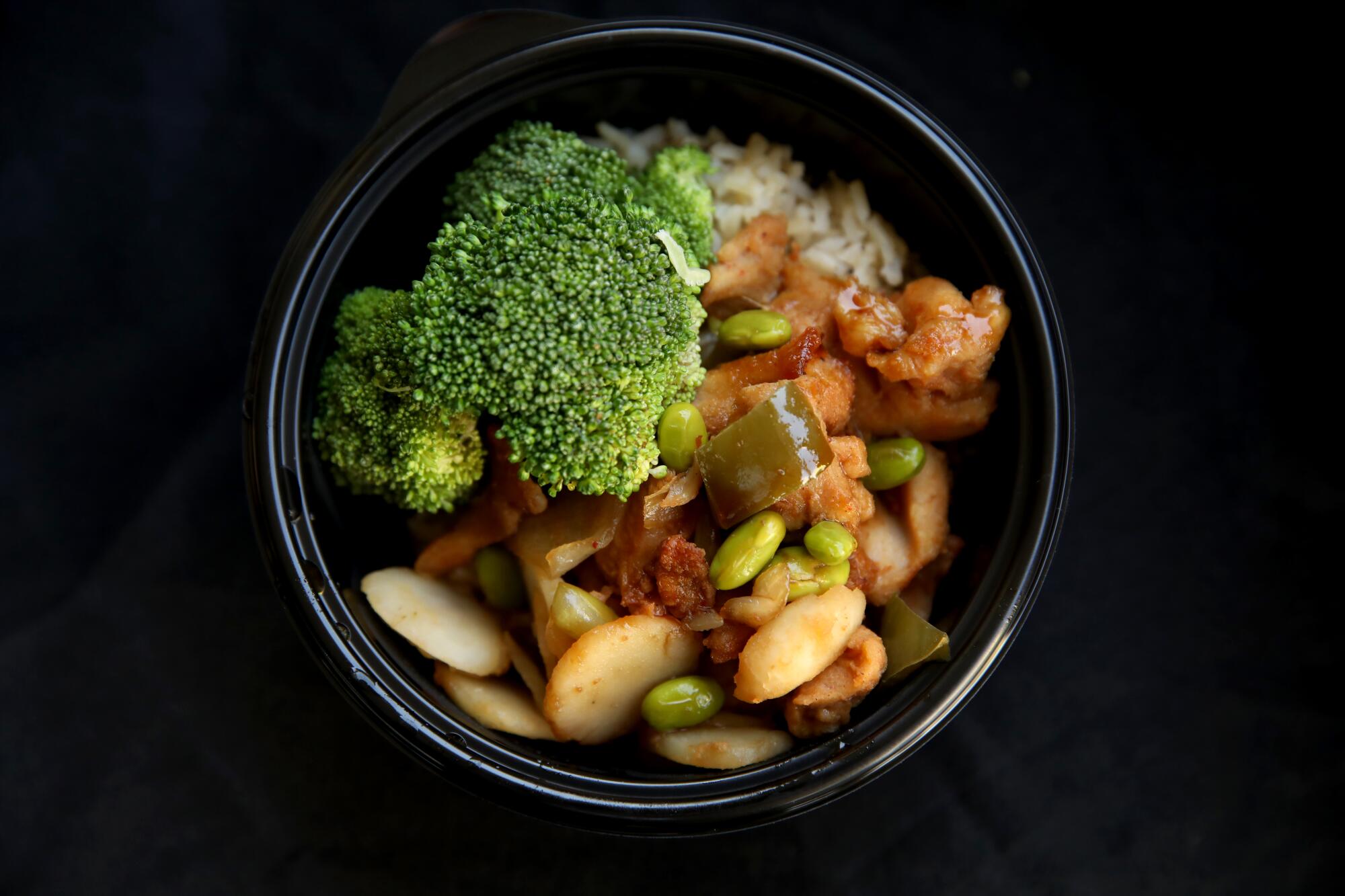
The feedback resulted in a few new items this year, including kung pao chicken with vegetables over rice; a ramen bowl with edamame; and a carnitas bowl to celebrate Hispanic Heritage Month in October.
With a new menu rollout twice a year, in addition to limited-time offerings, the process for introducing more options can be lengthy, convoluted and expensive. It starts with various vendors who present items to the Café L.A. team inspired by food trends and what they believe will resonate with students. For each item, vendors must provide documentation that ensures products meet specific nutrition requirements.
All meals must follow multiple sets of guidelines including the LAUSD nutrition policy and standards, and USDA and California rules, regulations and nutritional requirements including meal patterns and dietary specifications.
Senior nutrition specialist Ivy Marx and a nutrition team make sure specifications such as the correct ounces of protein and grains are met. The USDA also has specific requirements for the types of vegetables (dark greens once a week, a bean or legume and also something orange or red such as carrots), a target amount of milk (one cup per meal) and fat and calorie counts for each grade.

The vendors also must guarantee that they can provide the food in large enough quantities.
“You’re talking about something that could potentially be 300,000 servings for one day,” says Florence Simpson, food services deputy director.
When the Café L.A. team introduced the carnitas bowl, they had to go through the process above to source the ingredients from multiple vendors. Inflation and the ongoing drought in California have compounded the difficulties Simpson and her team face when sourcing ingredients for the various dishes. And all of the products need to be sourced from the U.S., unless American is unavailable or substantially higher in price.
“With global warming happening and all the heat that we’ve had in California, even though we are in the heartland of where produce comes from, we’re not able to procure those goods,” Simpson says.
Recently, there were plums, nectarines and peaches on a Monday menu. Simpson received a call from her supplier the previous Friday afternoon letting her know that he didn’t have enough crops to supply the coming week’s order. She was already having issues sourcing romaine lettuce, something that usually doesn’t happen until the winter months.
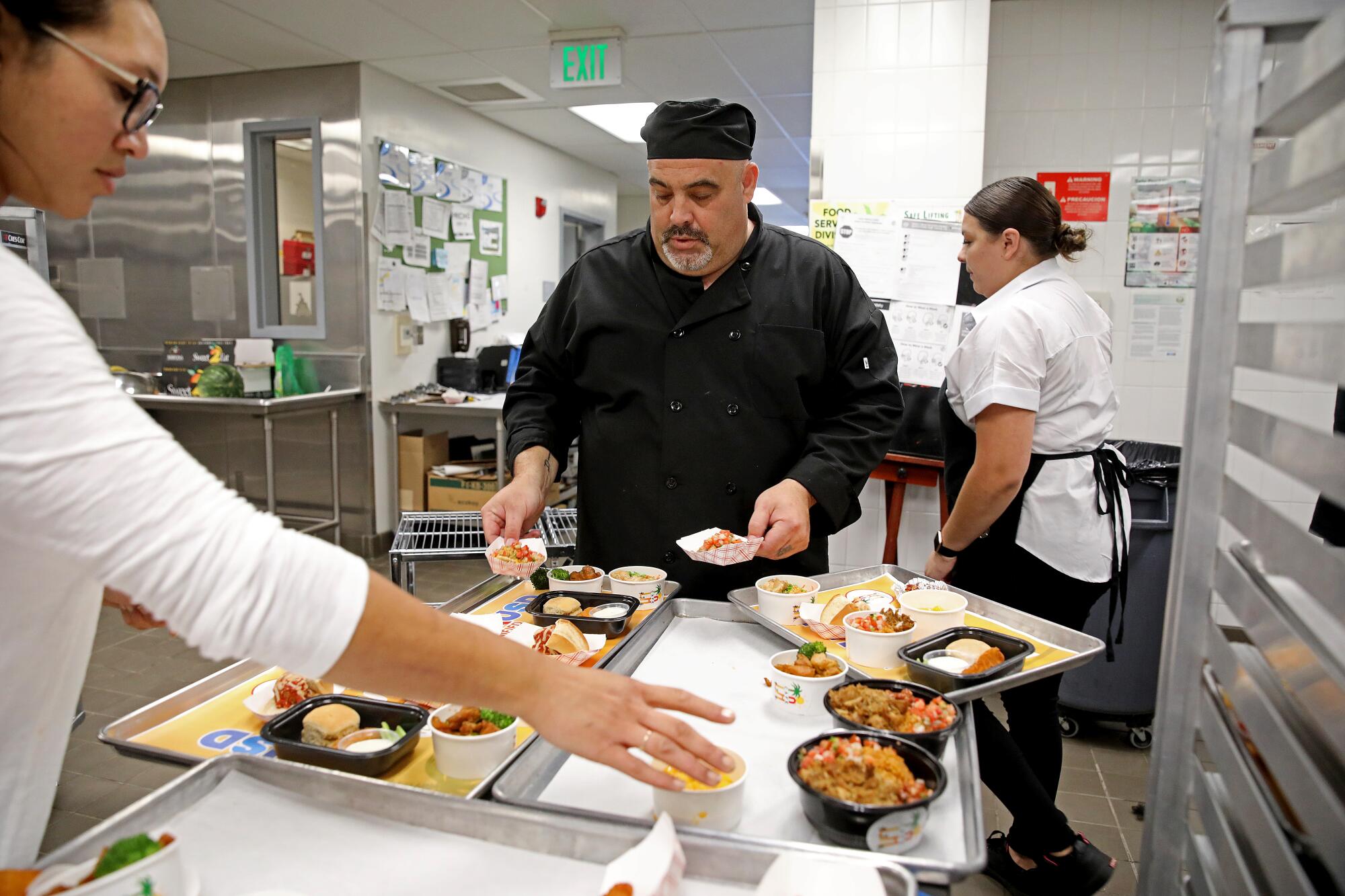
When something isn’t available, Simpson is left scrambling to find thousands of products at market price, sometimes raising the price per serving by 20 cents.
Once all the ingredients are sourced, the assembled dishes need to be tested.
“Just like any recipe, it takes multiple times and multiple iterations before we get it right in a small batch,” Simpson says. “Then we use managers like Mario to prepare a large batch for his school. So we go from a batch of, say, 30 to 50 to having him produce it for 500 to 800 students.”
But nothing makes it onto the menu without student approval. Multiple student tastings happen at some schools across the district throughout the year. After the food is served, students are given thumbs-up or -down cards. In order for something to be considered for an upcoming menu, it must have a 75% to 80% approval rating. Vendors are given the chance to improve items based on feedback such as a protein being too chewy.
“We live in Los Angeles — people want flavor,” says Manish Singh, director of food services. “I’m Indian, I need flavor. The kids need the same.”
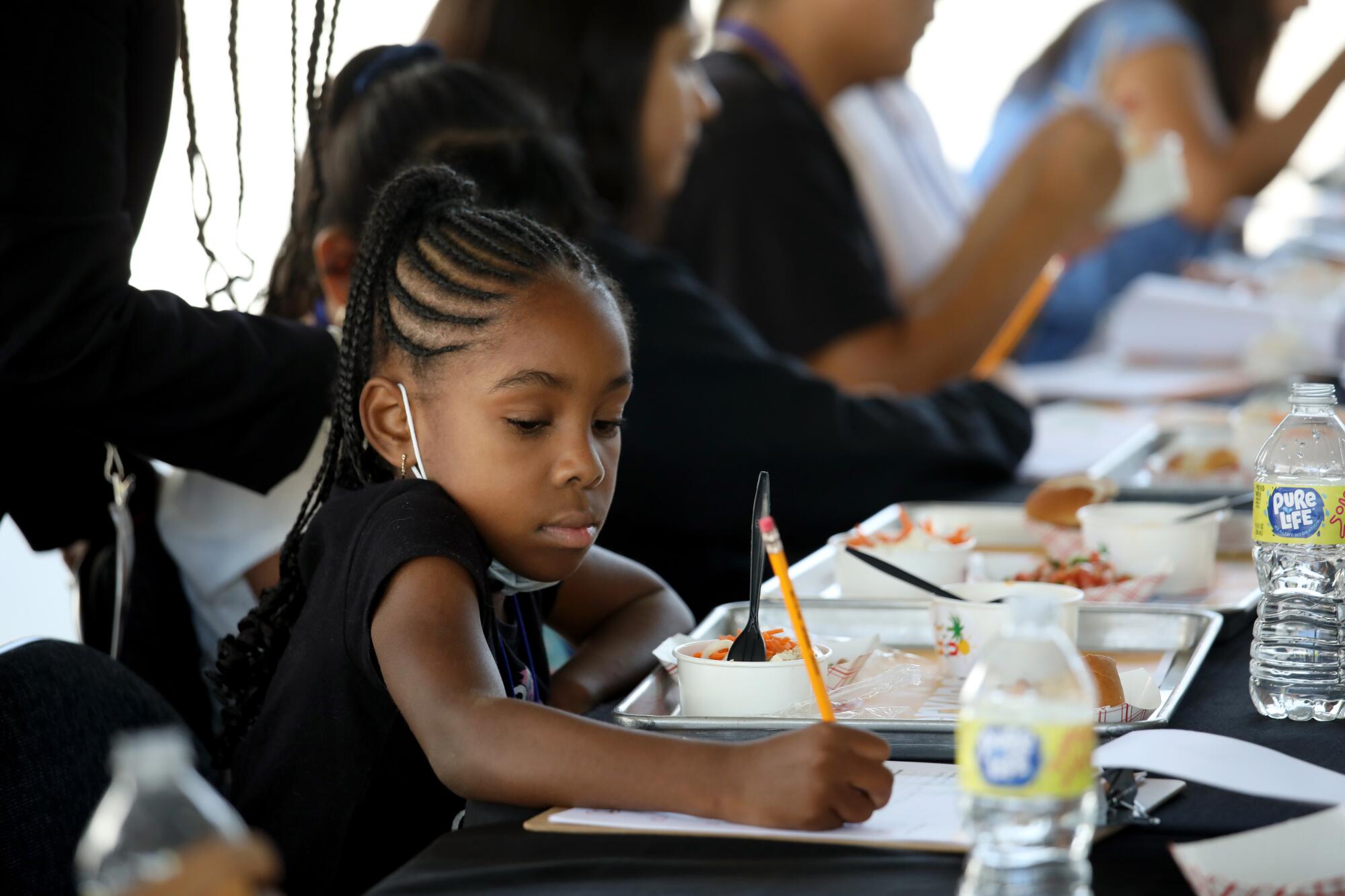
Singh notes the most popular dish served over the years is hot wings, an item that was discontinued four years ago. When I ask Flores and his friends what they’d like to eat for lunch if they could have anything in the universe, the answer was a resounding “hot wings.” But with rising costs and supply chain issues, it’s simply not an option at the moment. The Nashville-inspired tenders were designed as a hopeful consolation.
Funding the meals is its own challenge.
Starting this school year, all public schools in California must provide free breakfast and lunch to students in grades transitional kindergarten through 12 thanks to California’s Universal Meals Program. Before the pandemic, parents and guardians with eligible incomes — who weren’t already part of a free meal service option for districts in low-income areas — applied for the National School Lunch Program to subsidize meals.
Free school lunch and breakfast will be available this year to California public school students as part of the Universal Meals Program. LAUSD is providing three meals a day.
According to the Los Angeles Trust for Children’s Health, more than 84% of LAUSD students live at or below the poverty line, in a district with one of the state’s highest concentrations of low-income students.
The district works with a set budget and receives a federal reimbursement of $2.83 for each breakfast and $4.43 for each lunch. That’s an increase of about 15 cents for breakfast and 40 cents for lunch from the previous school year to help with rising costs. But not all meals are considered reimbursable.
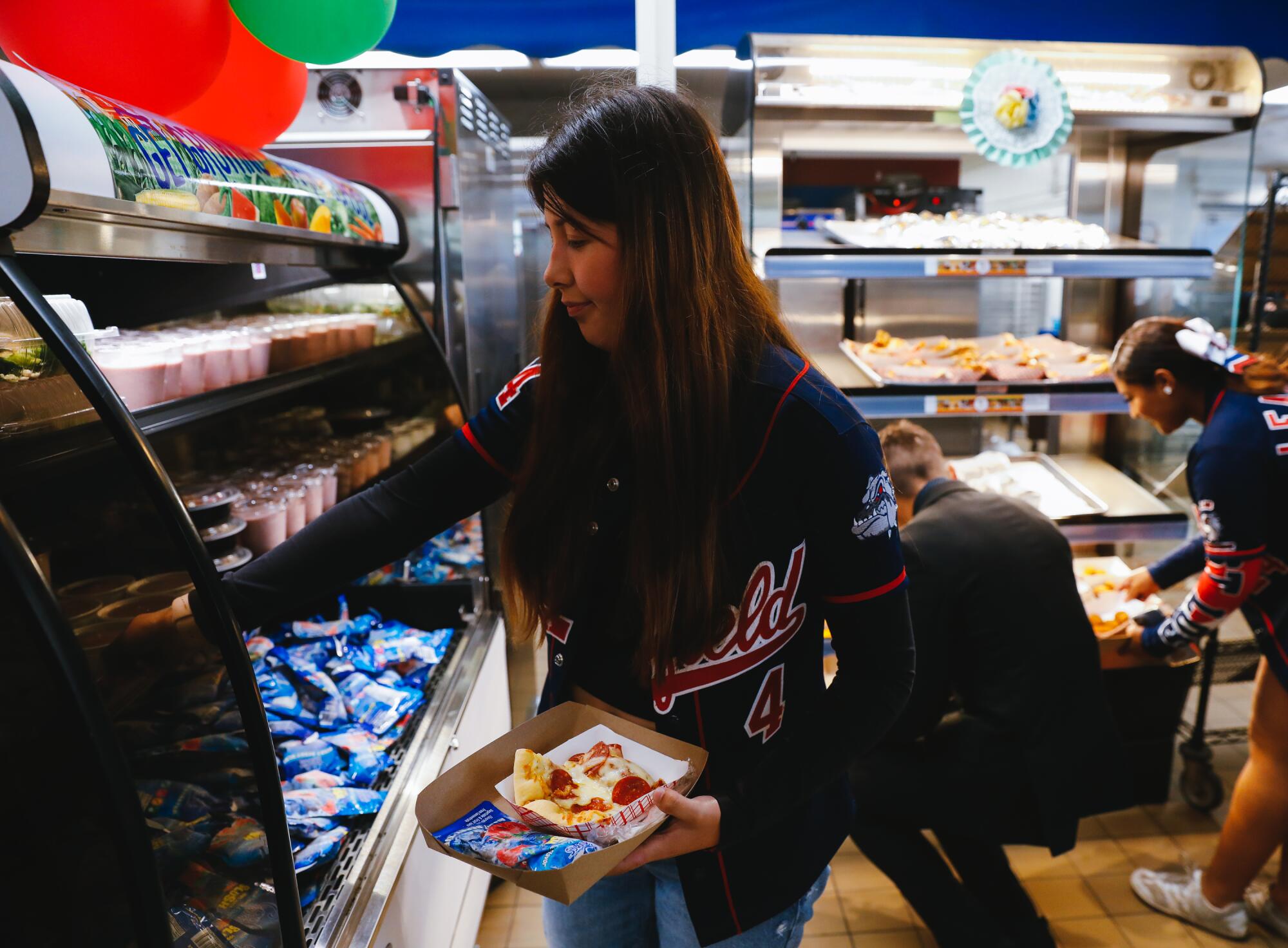
In order to receive the reimbursement for each meal served, the students must leave the cafeteria line with certain items on their trays. Each cafeteria uses a system of “offered versus served” in which students are offered and served a specific amount of grains, protein, vegetables, fruit and dairy. For breakfast, they are offered four and required to take three; one must be a fruit. At lunch, they are offered five and required to take at least three, including one fruit or vegetable.
After a student builds their own tray, a staff member looks over the tray to make sure the required components are present.
“If the student didn’t have a fruit or vegetable, then we kindly suggest, encourage,” Marx says. “’What do you think? A bag of carrots, you know, maybe an apple?’ And then they can go on their merry way.”
If a student doesn’t eat that required bag of carrots or apple, there’s a “share table” where students can drop or pick up items they may want to eat throughout the day. The offered versus served model and the share table are designed to cut down on food waste.
It’s a system that takes a certain amount of monitoring by the cafeteria staff that differs in diligence and difficulty depending on the grade. Fiore notes that it’s much easier to tell a 17-year-old to grab an apple than it is to convince a 6-year-old to add a vegetable to their tray. He estimates that he needs to remind 10 out of every 100 high school students to take a fruit or vegetable.
“We’re advocating for one meal plan with one set of regulations and one set of reimbursements,” says Simpson. “Because more than anything, our cafeteria managers and staff, they can’t just focus on feeding students. … And that takes the focus away from actually providing really good, nutritious meals.”
If a student walks out without the correct number of components on the tray, that meal is not considered reimbursable.
Revised version of signature L.A. Unified plan to address learning loss through extra school days attracts limited participation, about 11% of students sign up.
Fiore uses a computer program that logs participation numbers and menu items for each day of the week to help him anticipate how much food he’ll need for that day. If it’s raining or there is a pep rally, he’s learned to prepare a little less.
With the given reimbursement model, funding is directly tied to the number of kids willing to partake in the free lunch. According to Singh, participation for elementary school children hovers around 80% to 85%. That number drops to 45% for middle school children and even further, to 28% to 35%, for high school kids.
He hopes the new free lunch program will help reduce the stigma attached to kids who have to apply for a free lunch and those who can afford to pay. He’s also hoping to boost participation numbers with the new YumYummi app, which launched in 2022. It’s a way for kids to view menus, nutrition information and allergens and leave feedback.
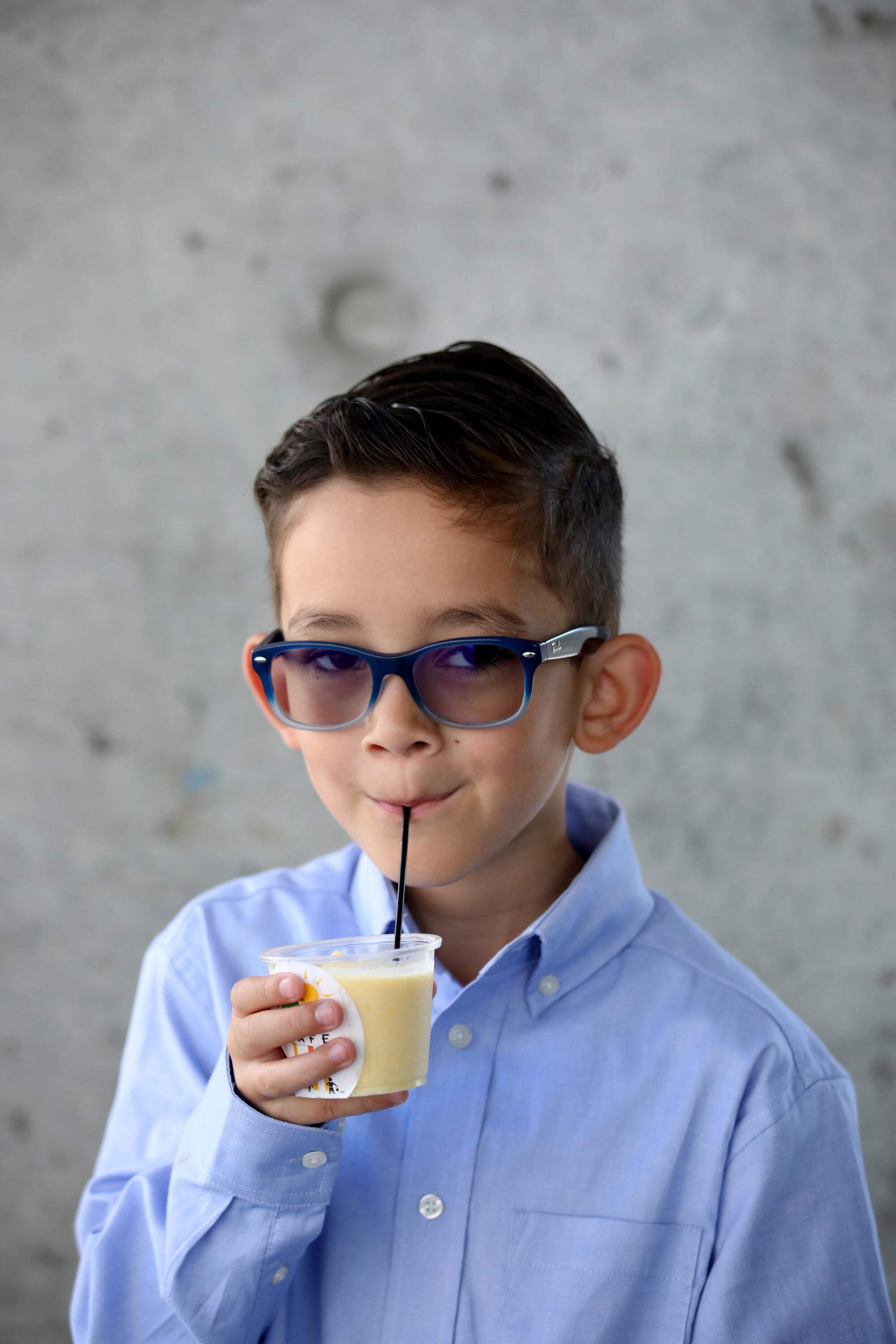
LAUSD also applied for USDA and state funds that would allow the district to buy equipment to increase the availability of certain items and introduce more options (Garfield has a new immersion blender it uses for smoothies) and also to invest in nutrition education for student leaders to become ambassadors and encourage peer-to-peer learning.
“We’re just starting to build momentum on the program,” says Simpson. “Every dollar that you put into child nutrition, you’re going to benefit further down the line.”
Flores and his classmates also hope that some of those dollars find their way to funding the return of the beloved hot wings.
“They used to look very similar to the Chuck E. Cheese hot wings and that’s why I liked them,” Flores says wistfully. “They are so good.”
But he only allows himself a few seconds to lament the wings. In one swift motion, he shoves the rest of his pizza into his mouth and swings a backpack over his shoulder, then runs out to join the pep rally.
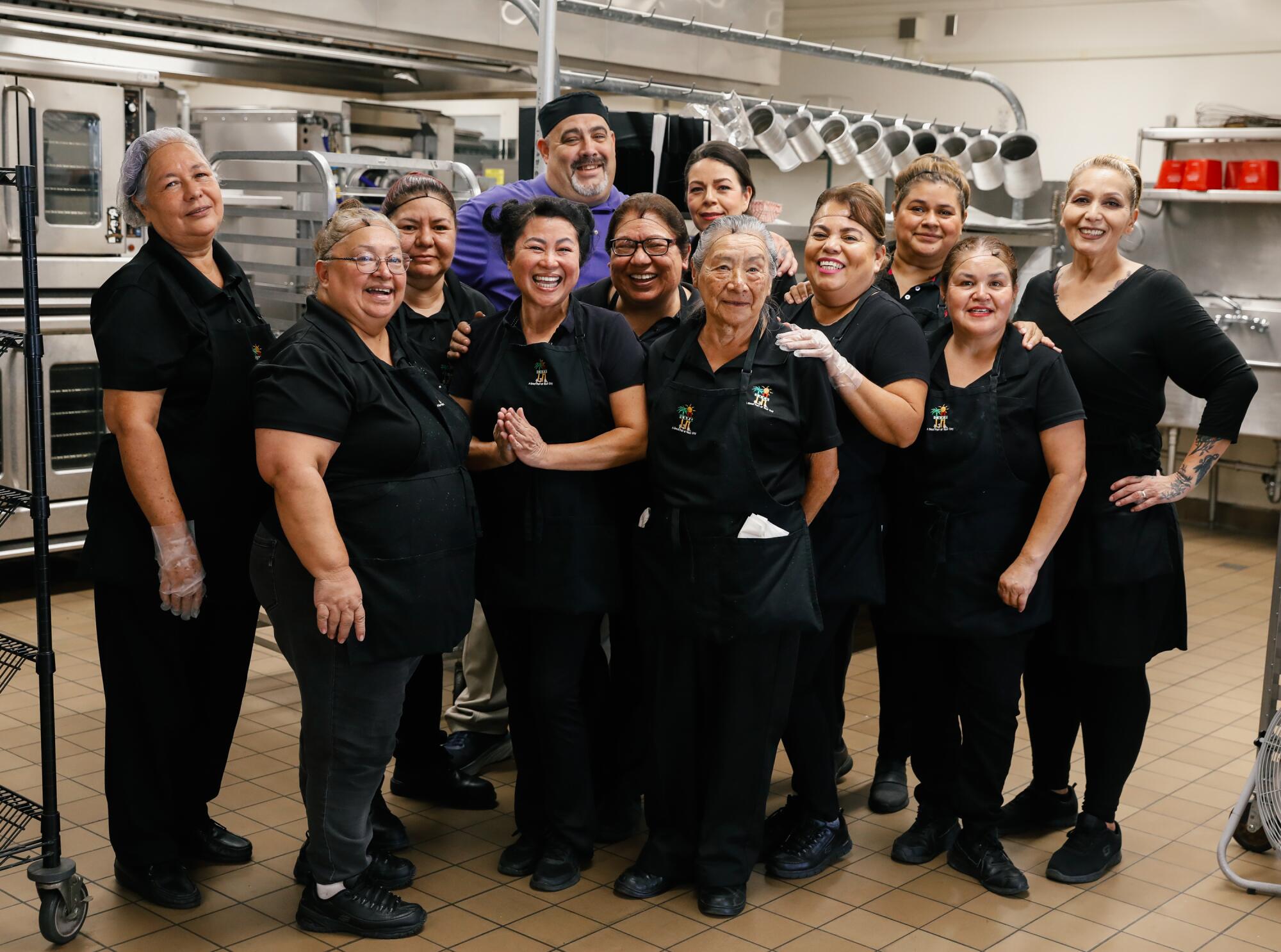
More to Read
Eat your way across L.A.
Get our weekly Tasting Notes newsletter for reviews, news and more.
You may occasionally receive promotional content from the Los Angeles Times.
